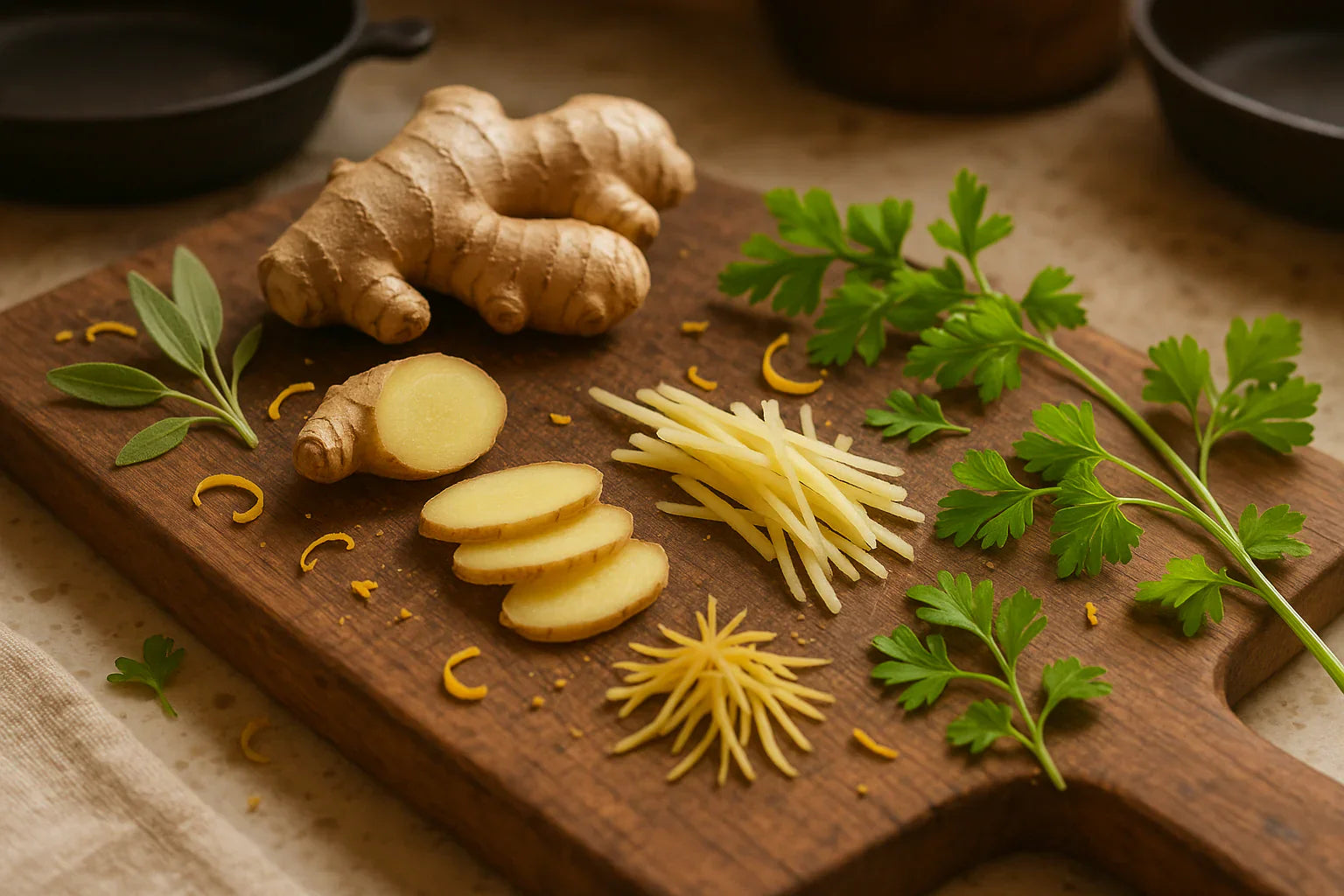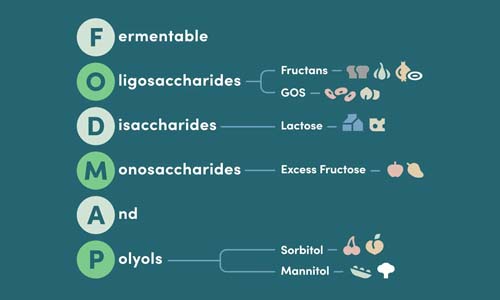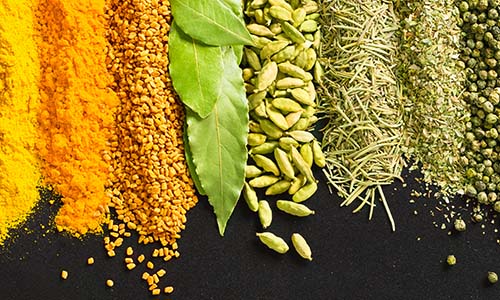Is Ginger Low FODMAP? Forms, Serving Sizes & Recipes

Key Takeaways
- Ginger is low FODMAP when used in standard culinary portions.
- The low FODMAP diet helps manage digestive discomfort for people with IBS.
- Ginger serves as a flavorful spice suitable for sensitive digestion.
- Using ginger allows for creating restaurant-quality dishes that are gut-friendly.
Table of Contents
- Ginger: Your Gut-Friendly Gateway to Bold Flavor
- What Makes Ginger Low FODMAP Safe
- Fresh vs. Dried vs. Pickled: Complete FODMAP Breakdown
- Maximizing Ginger's Potential in Low FODMAP Cooking
- How Ginger Compares to Other Low FODMAP Flavor Builders
- Ginger Tea and Beverages: Safe Brewing and Delicious Ideas
- Best Low FODMAP Ginger Recipes
- Solving Common Ginger-Related Problems on a Low FODMAP Diet
- Ginger vs. Other Low FODMAP Spices: Flavor & Function
- Reading Labels and Shopping for Low FODMAP Ginger Products
- Advanced Ginger Techniques for Maximum Flavor Impact
- Conclusion: Your Ginger-Forward Low FODMAP Future
Ginger: Your Gut-Friendly Gateway to Bold Flavor
If you're navigating the low FODMAP diet, designed to ease digestive discomfort for those managing IBS, you've likely wondered: is ginger low FODMAP? The answer delivers excellent news for flavor enthusiasts. Ginger is indeed low FODMAP in standard culinary portions, making it a cornerstone spice for creating restaurant-quality dishes that are gentle on sensitive digestion.
For those seeking inspiration, you can explore a variety of low FODMAP recipes that showcase ginger's versatility in both savory and sweet dishes.
What Makes Ginger Low FODMAP Safe

FODMAPs are specific fermentable carbohydrates that can trigger bloating, gas, and digestive discomfort in sensitive individuals. The acronym covers five sugar types: fermentable oligosaccharides, disaccharides, monosaccharides, and polyols. When these compounds reach the large intestine undigested, they ferment rapidly, causing symptoms.
Ginger low FODMAP status stems from its unique carbohydrate profile. Unlike high-FODMAP aromatics such as garlic bulbs or onions, ginger contains negligible amounts of these problematic sugars in typical cooking quantities. This makes it a safe harbor for those seeking bold flavor without digestive consequences.
The science is clear: Monash University's FODMAP testing confirms that both fresh and dried ginger remain below threshold levels that typically trigger symptoms. This positions ginger as an essential building block for creating the complex flavor profiles that make low FODMAP cooking genuinely satisfying rather than restrictive.
Fresh vs. Dried vs. Pickled: Complete FODMAP Breakdown
Understanding ginger FODMAP status across different forms ensures you can confidently stock your pantry and maximize flavor options. Each preparation method affects both potency and serving size guidelines.
| Ginger Form | FODMAP Status | Safe Serving Size | Best Culinary Use |
|---|---|---|---|
| Fresh Ginger | Low FODMAP | Up to 5g (1 tsp grated) | Stir-fries, marinades, teas |
| Ground Dried Ginger | Low FODMAP | Up to 1 tsp | Baking, spice blends, broths |
| Pickled Ginger | Low FODMAP* | Up to 2 tbsp | Sushi, salads, palate cleanser |
| Crystallized Ginger | Check labels | Varies by sweetener | Desserts, snacking |
*Pickled ginger maintains low FODMAP status when prepared with rice vinegar and cane sugar, but avoid versions sweetened with high-FODMAP alternatives like agave or honey.
The key insight: is ginger low FODMAP depends partly on processing. While fresh and dried forms are universally safe, processed versions require label scrutiny to avoid hidden high-FODMAP additives that can sabotage your digestive comfort.
Maximizing Ginger's Potential in Low FODMAP Cooking
Proper ginger technique transforms this humble rhizome into a flavor powerhouse that rivals traditional high-FODMAP aromatics. The secret lies in understanding how different preparation methods release varying intensities of ginger's bioactive compounds.
Three Foolproof Preparation Methods
Grating for immediate impact: Fresh grated ginger releases maximum oils and provides intense, bright heat. Use 1 teaspoon grated ginger to replace the aromatic base typically provided by garlic cloves in traditional recipes.
Slicing for subtle infusion: Thin ginger coins (2-3 pieces per serving) infuse broths and sauces with gentle warmth without overwhelming delicate flavors. This technique works beautifully with Gourmend's bone broths, where ginger complements the existing chive and leek green aromatics.
Muddling for beverages: Lightly crushing fresh ginger releases oils gradually, perfect for teas and cocktails. One thumb-sized piece per cup provides sustained flavor without bitterness.
The critical factor: respect serving sizes even when ginger is low FODMAP. Individual tolerance varies, and starting with smaller amounts allows you to gauge your personal threshold while building confidence in this versatile spice.
How Ginger Compares to Other Low FODMAP Flavor Builders

When traditional high-FODMAP aromatics are off-limits, understanding how ginger low FODMAP status stacks against other safe options helps you architect complex, satisfying flavor profiles. Each spice brings distinct characteristics to your culinary toolkit.
Ginger delivers warming heat and subtle sweetness, making it ideal for both savory applications and desserts. Its bioactive compounds provide anti-inflammatory benefits while creating the aromatic foundation typically supplied by garlic bulbs in conventional cooking.
Turmeric offers earthy depth with similar anti-inflammatory properties but lacks ginger's heat signature. Cumin provides smoky complexity perfect for Mediterranean and Middle Eastern profiles. Fresh chives contribute mild onion-like notes without the FODMAP load of onion bulbs.
The strategic advantage: combining ginger with these complementary low FODMAP spices creates layered complexity that satisfies even sophisticated palates. This approach forms the foundation of Gourmend's seasoning philosophy, flavor-forward, gentle on digestion, and never restrictive.
Ginger Tea and Beverages: Safe Brewing and Delicious Ideas
Fresh ginger tea delivers warming comfort without triggering digestive symptoms when prepared correctly. For a single cup, grate 1 teaspoon of fresh ginger (approximately 5g) and steep in hot water for 5-7 minutes. This extraction method releases ginger's aromatic compounds while maintaining its low FODMAP status, the key is staying within that tested serving size threshold.
Dried ginger powder works equally well for tea preparation, requiring only 1/2 teaspoon per cup due to its concentrated nature. Both methods create a naturally caffeine-free beverage that supports digestive comfort. For enhanced flavor complexity, add a squeeze of fresh lemon juice or a few fresh mint leaves, both low FODMAP additions that complement ginger's warming properties.
| Tea Type | FODMAP Status | Flavor Profile | Best Brewing Method |
|---|---|---|---|
| Fresh Ginger | Low FODMAP (1 tsp grated) | Bright, spicy, warming | 5-7 minute steep |
| Dried Ginger | Low FODMAP (1/2 tsp powder) | Concentrated, earthy heat | 3-5 minute steep |
| Green Tea with Ginger | Low FODMAP combination | Grassy, gently spiced | Add ginger to green tea |
| Rooibos with Ginger | Low FODMAP combination | Sweet, vanilla-like, warming | Longer steep (8-10 minutes) |
Best Low FODMAP Ginger Recipes
These three signature recipes showcase ginger's versatility while adhering to strict low FODMAP guidelines. Each recipe serves four and incorporates Gourmend's clean-label approach, no hidden high FODMAP ingredients, just bold flavor that's gentle on digestion.
Carrot-Ginger Soup: Sauté 2 cups diced carrots and 1/4 cup green leek tops in olive oil. Add 4 cups Gourmend shelf-stable broth carton, 2 teaspoons fresh grated ginger, and simmer 20 minutes. Blend until smooth, season with salt and pepper. The natural sweetness of carrots balances ginger's heat perfectly. For a detailed step-by-step, see this low FODMAP carrot ginger soup recipe.
Ginger-Scented Quinoa Pilaf: Toast 1 cup quinoa with 1 teaspoon ground ginger until fragrant. Add 2 cups Gourmend vegetable broth, bring to boil, then simmer covered for 15 minutes. Fluff with fork and stir in chopped chive sprigs. This side dish transforms simple quinoa into restaurant-quality accompaniment.
Fresh Ginger Lemonade: Combine 1/4 cup fresh lemon juice, 2 teaspoons grated fresh ginger, 2 tablespoons maple syrup, and 4 cups cold water. Strain after 10 minutes for smooth texture, or leave unstrained for rustic presentation. This refreshing beverage proves that is ginger low fodmap concerns shouldn't limit your creativity, when prepared thoughtfully, ginger enhances rather than restricts your culinary options.
Solving Common Ginger-Related Problems on a Low FODMAP Diet

Even with ginger's excellent low FODMAP credentials, individual tolerance varies. If you experience symptoms after consuming ginger, first verify your serving size, many people unknowingly exceed the 5g fresh ginger threshold, especially when using pre-minced jarred varieties that pack more densely than freshly grated ginger.
Reintroduction Strategy: Start with 1/4 teaspoon ground ginger or a pea-sized piece of fresh ginger. Wait 24 hours, monitor symptoms, then gradually increase to the full low FODMAP serving if tolerated. This methodical approach helps distinguish true ginger sensitivity from portion-size issues.
Hidden ingredients pose another common problem. Crystallized ginger often contains high FODMAP sweeteners like honey or agave syrup. Similarly, ginger supplements may include inulin or other problematic fillers. Always choose products with single-ingredient labels: "ginger" and nothing else. For pickled ginger, verify that rice vinegar and salt are the only additional ingredients, avoid versions with added sugars or artificial sweeteners that could trigger symptoms.
When ginger products seem limited in your area, consider growing fresh ginger root at home or ordering organic, single-ingredient dried ginger online. This ensures you control every aspect of your ginger consumption while maintaining the flavor complexity that makes low FODMAP cooking satisfying rather than restrictive. For more meal inspiration, check out this simple low FODMAP gourmet risotto recipe.
Ginger vs. Other Low FODMAP Spices: Flavor & Function
Understanding how ginger compares to other low FODMAP spices helps you build complex flavor profiles without digestive compromise. While ginger provides warming heat and subtle sweetness, turmeric offers earthy bitterness, cumin delivers smoky depth, and fresh chives contribute mild onion-like flavor, each filling distinct culinary roles.
| Spice | Flavor Profile | Heat Level | Best Culinary Use | Low FODMAP Serving |
|---|---|---|---|---|
| Fresh Ginger | Warming, slightly sweet, zesty | Mild to moderate | Asian dishes, teas, baking | Up to 5g (1 tsp grated) |
| Ground Turmeric | Earthy, slightly bitter, peppery | Very mild | Curries, rice dishes, golden milk | Up to 1 tsp |
| Cumin Seeds | Smoky, nutty, warm | Mild | Mexican, Middle Eastern cuisine | Up to 1 tsp |
| Fresh Chives | Mild onion-like, grassy | None | Garnish, egg dishes, soups | Up to 1 tablespoon chopped |
Ginger excels in both sweet and savory applications, making it more versatile than single-purpose spices like cumin. Its natural compounds also provide digestive benefits beyond flavor, a unique advantage that positions ginger as both seasoning and functional ingredient. When building spice blends for low FODMAP cooking, ginger pairs exceptionally well with turmeric for anti-inflammatory golden pastes, or with chives for Asian-inspired stir-fries using Gourmend shelf-stable broth carton as the flavor base.
For a deeper dive into ginger's history and uses, see the Wikipedia entry on ginger.
Reading Labels and Shopping for Low FODMAP Ginger Products
Successful low FODMAP shopping requires vigilance beyond checking for obvious high FODMAP ingredients. Ginger products frequently contain hidden sugars, thickeners, and preservatives that can trigger symptoms even when ginger itself remains perfectly safe. Focus on single-ingredient products whenever possible, the ingredient list should read simply "ginger" with no additional components.
Red Flag Ingredients to Avoid: High fructose corn syrup, honey, agave nectar, inulin, chicory root extract, and any ingredient ending in "-ose" except glucose. These additions can transform a low FODMAP ginger product into a digestive trigger.
Crystallized ginger presents particular challenges since the crystallization process requires sweeteners. Look for versions sweetened with cane sugar rather than honey or agave, cane sugar remains low FODMAP in reasonable portions. For pickled ginger, verify that rice vinegar and salt are the only additives. Many commercial versions include artificial colors or flavor enhancers that, while not necessarily high FODMAP, contradict clean-label principles.
When shopping online, read customer reviews specifically mentioning digestive tolerance. Gourmend customers often share experiences with various ginger products, helping you identify brands that consistently deliver pure, additive-free options. This community knowledge proves invaluable when is ginger low fodmap concerns extend beyond the spice itself to encompass processing methods and hidden ingredients. For more on the science behind FODMAPs and digestive health, see this peer-reviewed article on FODMAPs and gut health.
Advanced Ginger Techniques for Maximum Flavor Impact

Professional chefs maximize ginger's impact through strategic preparation and timing techniques that home cooks can easily master. Grating ginger releases more aromatic compounds than slicing, while bruising whole pieces with the flat side of a knife creates subtle background flavor without overwhelming heat, perfect for delicate dishes where is ginger low fodmap serving sizes must be respected.
Temperature control dramatically affects ginger's flavor contribution. Adding fresh ginger early in cooking processes mellows its heat and develops complex sweetness, while incorporating it during final minutes preserves bright, zingy notes. For maximum efficiency, prepare ginger ice cubes by freezing grated fresh ginger in small portions, this preserves peak flavor while ensuring accurate portion control for low FODMAP compliance.
Infusion techniques expand ginger's applications without increasing FODMAP load. Steep ginger slices in warm Gourmend shelf-stable broth carton for 10 minutes, then remove the solids, you retain ginger's essence while staying well within safe serving parameters. This method works particularly well for sensitive individuals who love ginger flavor but need to minimize direct consumption of the root itself.
Conclusion: Your Ginger-Forward Low FODMAP Future
Ginger stands as one of the most reliable and versatile spices in the low FODMAP arsenal, offering bold flavor without digestive compromise when used thoughtfully. From fresh tea preparations to complex recipe applications, understanding that is ginger low fodmap in appropriate serving sizes opens countless culinary possibilities rather than imposing limitations.
The key to ginger success lies in precision, measuring portions accurately, reading labels carefully, and choosing single-ingredient products whenever possible. Whether you're grating fresh ginger for morning tea or incorporating ground ginger into baked goods, these evidence-based guidelines ensure you can enjoy ginger's warming complexity without triggering symptoms.
Your low FODMAP journey doesn't require sacrificing the bold, gourmet flavors you crave. With ginger as a foundational spice and Gourmend's clean-label broths and seasonings supporting your culinary creativity, abundant flavor and digestive comfort can coexist beautifully. Explore our complete collection of low FODMAP recipes to discover how ginger transforms simple ingredients into restaurant-quality dishes that love you back.
Frequently Asked Questions
Is ginger safe to consume on a low FODMAP diet for people with IBS?
Yes, ginger is safe to consume on a low FODMAP diet when used in standard culinary portions. It provides bold, flavorful spice without triggering common digestive discomforts associated with IBS.
How do the FODMAP levels differ between fresh, dried, and pickled ginger?
Fresh, dried, and pickled ginger all remain low FODMAP within typical serving sizes. While drying concentrates flavors, the FODMAP content stays below threshold levels, and pickled ginger is generally safe unless combined with high FODMAP ingredients.
What serving sizes of ginger are considered low FODMAP and safe for sensitive digestion?
Standard culinary portions, such as about 1 teaspoon of fresh or dried ginger, are considered low FODMAP and safe for sensitive digestion. Staying within these amounts helps avoid excess fermentable carbohydrates.
Are there any types of ginger products that might contain high FODMAP ingredients to watch out for?
Yes, some ginger products like sauces or marinades may include high FODMAP ingredients such as garlic or onion. Always check labels carefully and choose products with simple, transparent ingredients to ensure gut-friendly choices.





